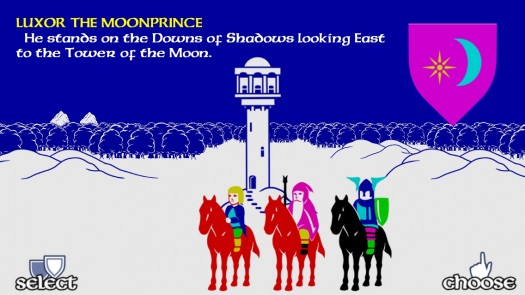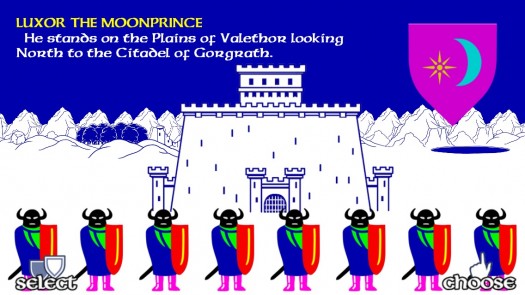 Mike Singleton’s The Lords of Midnight (Free) was originally released for the ZX Spectrum in 1984, on magnetic cassette tape. It was quite possibly the most ambitious game of its time, and you can see the roots of the modern open-world RPG in it as well as its influence on later strategy games and the development of the graphical adventure game. The iOS port is by Chris Wild, and his devotion to the game, and its sequel, Doomdark’s Revenge is obvious.
Mike Singleton’s The Lords of Midnight (Free) was originally released for the ZX Spectrum in 1984, on magnetic cassette tape. It was quite possibly the most ambitious game of its time, and you can see the roots of the modern open-world RPG in it as well as its influence on later strategy games and the development of the graphical adventure game. The iOS port is by Chris Wild, and his devotion to the game, and its sequel, Doomdark’s Revenge is obvious.
The first thing that will strike most players is the unique look of Lords of Midnight. Rather than embrace the “pixelated" look of most classic and retro games, Singleton and Wild decided to keep the aesthetic of the original, with its bright, crisp primary colors, while sharpening the images to the resolution of modern devices. The result is distinctive and perfectly lucid in its presentation of meaningful information, but it does take a little getting used to – at first, the game looks like a construction-paper version of Lord of the Rings.
Certainly Lords of Midnight is deeply and unabashedly indebted to Tolkien. The scenario is familiar: on the night of the winter solstice, the Witchking Doomdark invades the lands of the free. Disunited human lords, fey creatures of the forest, and tower-dwelling wizards must be united to fight him even as one unique individual, Morkin the half-Fey, sets out into the heart of the enemy’s territory in a perilous quest to destroy the Ice Crown, the focus of Doomdark’s power. There’s even a wretched Gollum-like creature, Fawkrin, who may play a crucial role in the story.
Unlike its inspiration, however, Lords of Midnight includes contingencies. To win, either the armies of Luxor the Moonprince must conquer Doomdark’s citadel of Ushgarak, or the Ice Crown must be destroyed. The game is lost only if Morkin is killed and the armies of the free are defeated. Moreover, there are are at least two ways to destroy the Ice Crown, but I’ll say no more of that…
Lords of Midnight bills itself as “epic" and still feels epic today, even thought the world is smaller and can be explored much faster than in a modern RPG. This is partially due to a remarkably clever multiple first-person perspective system and a turn-based mechanic in which each of your characters can use up the hours of the day independently, and then Doomdark’s forces move by night.
I keep comparing Lords of Midnight to the modern RPG, but the developers describe it as an “Adventure Strategy game." There are no levels to gain, or skills to learn in Lords of Midnight. Inventory plays a nominal role and is managed automatically, and combat is resolved instantaneously and without explanation. The look and feel, however, is much closer to Wizardry (1981) than Kings Quest (1984), and Morkin’s quest feels more like the sneaking about that Frodo and Samwise do than the object-use puzzles of text and graphic adventure games.
 I think modern players will find the Strategy component of the game more familiar, as it plays a bit like an ancestor of King’s Bounty (1990) and especially the subsequent Heroes of Might and Magic games. You recruit the diverse Lords of Midnight to your cause, and they in turn recruit infantry and horsemen at fortifications. Armies only travel with a hero/lord, and they can meet other armies on open ground or lay siege to the enemy’s keeps and citadels.
I think modern players will find the Strategy component of the game more familiar, as it plays a bit like an ancestor of King’s Bounty (1990) and especially the subsequent Heroes of Might and Magic games. You recruit the diverse Lords of Midnight to your cause, and they in turn recruit infantry and horsemen at fortifications. Armies only travel with a hero/lord, and they can meet other armies on open ground or lay siege to the enemy’s keeps and citadels.
Heroes without armies can fight Doomdark’s scattered minions (Wolves, Skulkrin, Trolls, and Dragons), but have no chance against an organized army. The difficulty curve is surprisingly flat for these lesser battles, and hard to predict unless your hero has one of the “-slayer"swords, which seem to give a 100% success rate against the specified enemy type.
In my first game, Mokin encountered wolves on the first turn. Figuring he could take a few wolves, I told him to fight, and then he was (permanently) dead. That’s it. One entire path to victory foreclosed before turn 2. In another case, I had a different hero fight dragons without an army or Dragonslayer sword on the first turn, and he slaughtered them.
This is one of the legacies of game design of the period that may make it hard for some fans of modern games to get into Lords of Midnight. Another is that not only do clashes between armies happen between turns, but there’s no combat report: to find out how many soldiers each side lost, you have to go to the Lord(s) in question (assuming any of your heroes still live).
Clues that are strategically helpful and/or relevant to Morkin’s quest can be garnered at towers and occasionally elsewhere, but the process is tedious and the average answer is useless, something like “the Lord of Utarg can be found at the keep of Utarg." It seems like the best strategy is to play a couple of games just to gather information (the game is not randomized in this way), and then play to win. On a related note, the in-game tutorial tells you that you don’t have to read the included novella, but if you don’t, you are likely to waste time trying strategies that are intended to be impossible, like trying to confront Doomdark’s armies head-on on the plains of Blood.
The game’s interface is well-designed for touch, and is easy to navigate and use with one significant caveat. At least on my 4th gen iPod Touch, I had to aim low on or even below the smaller icons in order to select them. This sometimes caused problems with the pop-up tutorials, where missing the small book icon could cause the selected character to move forward one “space."
 I mentioned the lucidity of the game’s art before: this is one of its greatest strengths. Unlike in most modern overrendered games, you always know what you’re looking at in Lords of Midnight. If there’s an army far off on the plain, you can see their banners but not make out their numbers. When seeking a magical “henge" or one of the towers of the Wise, you will be able to see it in the first-person view before it shows up on the automap (unless something tall, like a citadel or mountain range, is directly in the way).
I mentioned the lucidity of the game’s art before: this is one of its greatest strengths. Unlike in most modern overrendered games, you always know what you’re looking at in Lords of Midnight. If there’s an army far off on the plain, you can see their banners but not make out their numbers. When seeking a magical “henge" or one of the towers of the Wise, you will be able to see it in the first-person view before it shows up on the automap (unless something tall, like a citadel or mountain range, is directly in the way).
Once you get used to the game’s combat mechanics and the touch sensitivity, this clarity of vision makes it easy to avoid “stupid" mistakes. The way you can play a couple of minutes at a time with no worries about losing your progress and little concern over forgetting where you were shows both that the original game is suited to mobile play and that the adaptation plays to that strength.
If you’re interested in classic games, especially fantasy and/or strategy games, Lords of Midnight is a must-have. On the other hand, if you are an action gamer whose idea of “old school" is Goldeneye 64, you’ll want to give this one a pass.
Mike Singleton died this past fall, and with him any possibility of a long-intended final game rounding out the trilogy. Wild’s release of the iOS version on December 21st, 2012, the winter solstice and the night the world was “supposed to" end but did not, is a fitting tribute.


